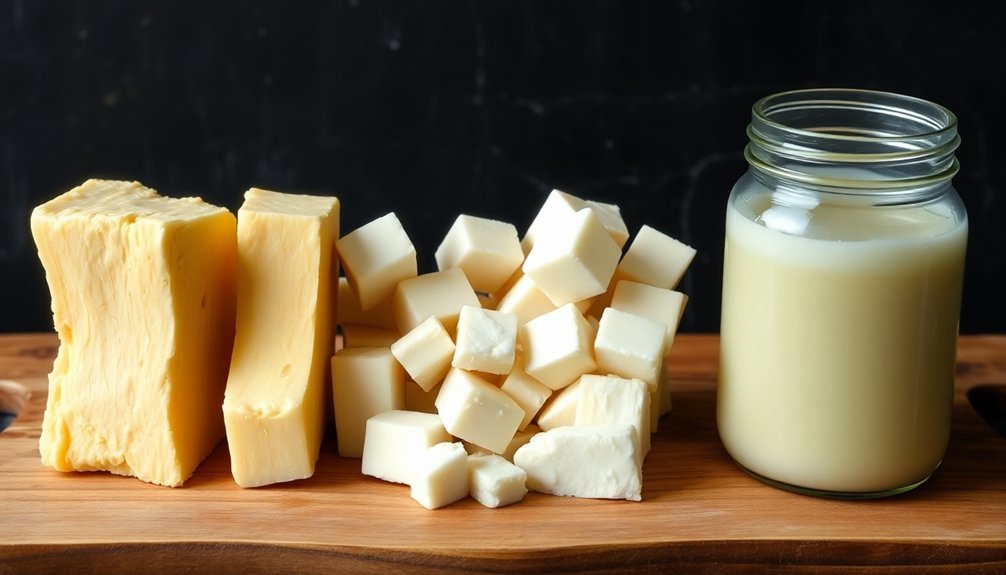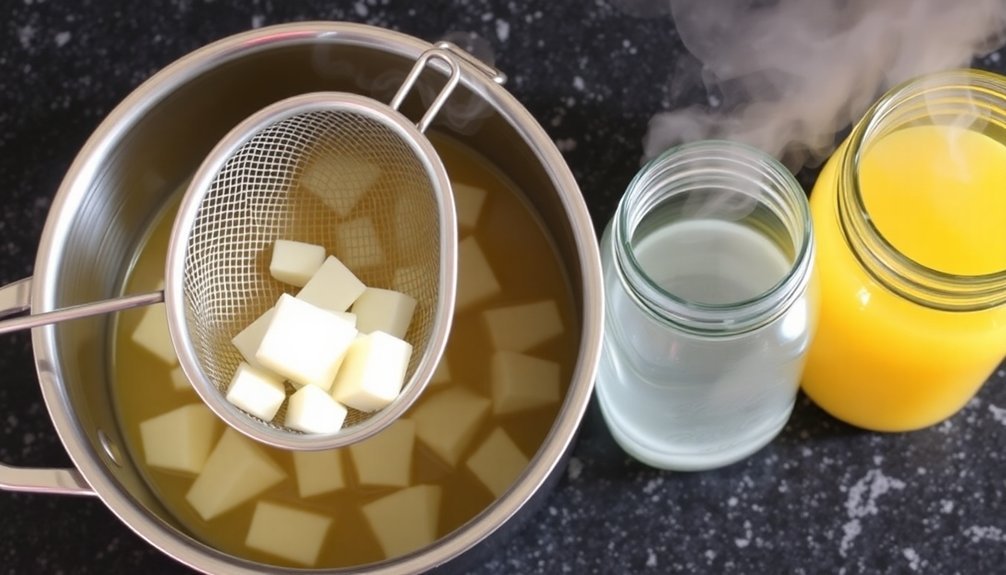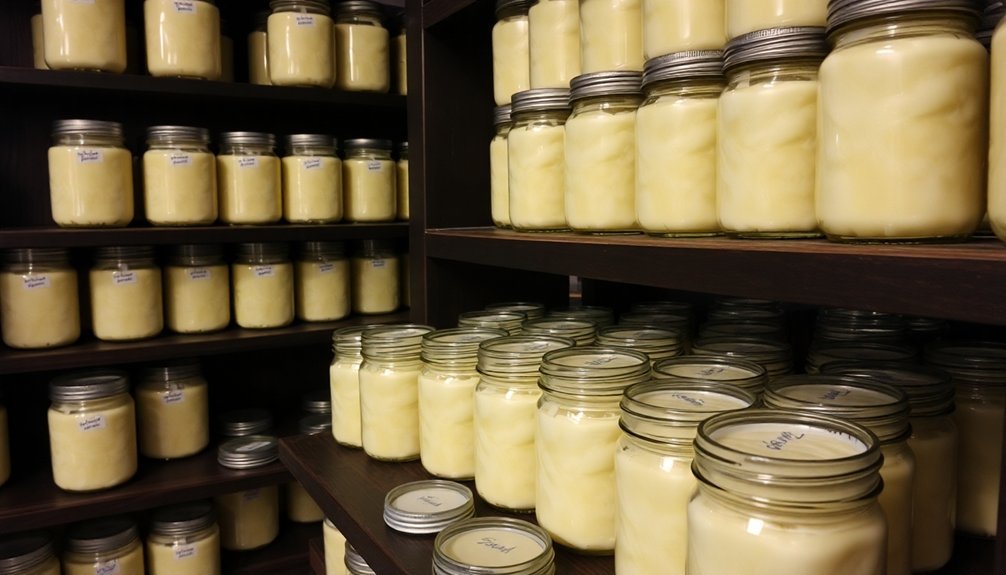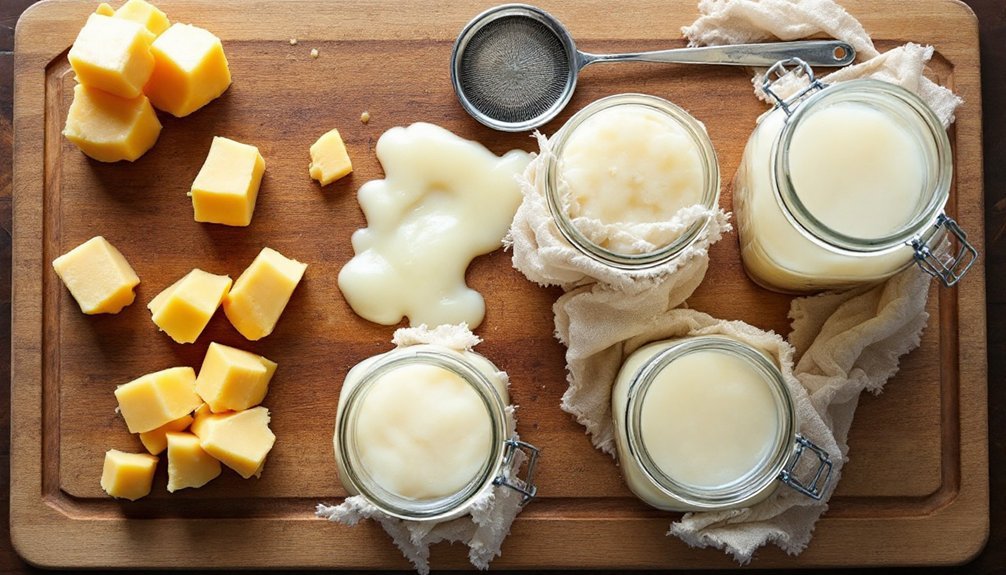To transform raw animal fat into pure soap-making tallow, you'll need to follow three key steps. First, cut fresh animal fat into small chunks and remove any meat or debris. Next, melt the fat chunks over low heat while stirring occasionally, then strain through a paper towel-lined strainer to remove impurities. Finally, store your rendered tallow in airtight containers in a cool, dark place. Master these fundamentals, and you'll be ready to explore advanced soap-making techniques.
Sourcing and Preparing Raw Animal Fat

When it comes to making soap with pure animal fat, obtaining quality raw materials is crucial for success. You can start sourcing raw animal fat by visiting local butchers and farmers who often have excess fat from beef, pork, or lamb that they'll sell or give away.
To prepare the fat for the rendering process, cut it into small chunks to guarantee even melting. Next, melt the fat over low heat, stirring occasionally until it's completely liquefied. Be careful not to burn it, as this can create unpleasant odors.
Once melted, remove any solid particles by straining the liquid through a paper towel-lined strainer to create a clean product for soap making. Finally, store rendered fat by pouring it into containers and placing them in the refrigerator to solidify.
Rendering and Straining Methods

The rendering process transforms raw animal fat into pure, high-quality soap-making material through careful heat application and filtering.
Through meticulous heating and filtration, animal fats transform into pristine, soap-ready material worthy of the finest handcrafted products.
To render fat, cut it into small pieces and melt it over low heat. You'll want to strain the melted fat through a paper towel-lined strainer to achieve clear tallow free from solid particles.
- Use non-aluminum utensils and containers to prevent unwanted reactions
- Apply low heat consistently to avoid unpleasant odors
- Add warm water in equal parts to the melted fat for enhanced purity
- Boil and simmer the mixture for 15 minutes
- Refrigerate overnight to separate remaining impurities
Store your rendered fat in an airtight container and keep it cool or refrigerated to maintain its quality.
This careful process guarantees your soap-making material remains pure and effective for your crafting needs.
Storing and Preserving Purified Tallow

Proper storage methods guarantee your purified tallow remains fresh and usable for up to two years. You'll need to store it in airtight containers and place them in a cool, dark place or refrigerator. Before sealing, verify your tallow is completely cooled to prevent moisture buildup. Don't forget to label containers with the rendering date to track freshness.
| Storage Method | Duration | Requirements |
|---|---|---|
| Room Temperature | 6 months | Airtight, dark place |
| Refrigeration | 1 year | Sealed container |
| Vacuum Sealed | 18 months | Proper sealing |
| Frozen | 2 years | Freezer-safe container |
For long-term storage, consider vacuum sealing or freezing your tallow. Always check for off-smells or discoloration during storage, and discard if necessary to maintain quality in your soap-making ingredients.
Frequently Asked Questions
Can You Make 100% Tallow Soap?
Yes, you can make 100% tallow soap. You'll need tallow, sodium hydroxide, and deionized water in precise measurements. It'll create a hard bar with great lather, but remember to cure it for 4-6 weeks.
How Do You Process Animal Fat?
You'll need to cut raw animal fat into small pieces, melt it slowly over low heat, stir occasionally, and strain the liquid through a paper towel-lined strainer. Store in a cool place.
Can Animal Fat Be Turned Into Soap?
Yes, you can turn animal fat into soap through saponification. When you combine rendered animal fats like tallow or lard with lye, they'll react to create soap and glycerin. It's a traditional soapmaking method.
How Do You Render Fat to Make Soap?
You'll need to chop the fat into small pieces, melt it slowly over low heat, strain out solids, then boil with water. After refrigerating overnight, remove the solidified fat from water for soap-making.
In Summary
You've now learned how to transform raw animal fat into pure, high-quality tallow for soapmaking. By carefully sourcing your fat, rendering it with patience, and straining it thoroughly, you'll create a pristine base for your handmade soaps. Store your rendered tallow properly, and it'll stay fresh for months. Whether you're making your first batch or you're an experienced soaper, these steps guarantee consistent results.





Leave a Reply